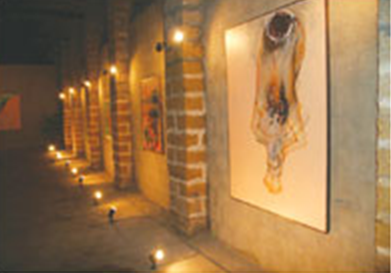The Karachi Commune
This is a collection of articles archived for the excellence of their content. Readers will be able to edit existing articles and post new articles directly |
Commune, The, Karachi
Fresh ideas and approaches
By Amra Ali
Driving down Miskeen Gali, off Old Queen’s road in Karachi, one encounters an old run down neighbourhood, with the elderly sitting on charpoys, overlooking small children playing on the street. A few glares suggest that this intrusion through an almost private street has not gone unnoticed. They seem to know why I am passing by and eagerly direct me to the old ware houses turned artists’ colony further ahead. Called the Commune, a group of equally old warehouses transformed into a sapcious gallery space, offices, meeting room and artists’ studios, is the brainchild of two creative people, ceramist Raania Azam Durrani and fashion designer Yousuf Bashir Qureshi. This space aspires to be a new breathing space for the visual and performing arts, in which the emphasis shifts from the finished work to incorporate a larger framework of creativity focusing on short and long workshops, talks, artists’ residencies, and a meeting place for creative people. Its multidisciplinary approach is what may separate the Commune from the commercial galleries in town, if it is able to establish its credibility as a center for nurturing the arts.
While the task of realigning established mindsets and patterns of habit will be a challenging one, I sense an energy that could contribute very positively toward a more open yet professional approach to art. The gallery itself will be suitable to larger works that are able to be viewed with proper lighting and adequate space around them. One of the gallery artists giving her time to help with the Commune, Sarah Bakhtiyar, showed her large scale works at the gallery’s opening show last year, and is presently conducting a workshop in mural painting. The façade of each of the warehouses located in the compound is ideal for murals, and in one of the projects Sarah has worked with the local children of Miskeen gali to involve these kids in creating the art on the walls. Apart from engaging the area community in art projects, the artists working here try to cultivate a sense of community and sharing by distributing clothes and other essentials to the surrounding area residents. Several other programmes such as short evening courses in fashion design and ceramics are also being offered to accommodate those working during the day.
On the day I visited, a show of paintings by Fareen Butt was being mounted. Butt, a visiting artist of Pakistani origin from New York displays small oils on canvas (about 8” x 8”), in sets of three, five, six or eight. The pairing of paintings into groups provides a rhythm to the overall concern with colour, space and form. Pointilist in treatment, each work, though appearing to be similar to the other, provides an interesting shift that sets the pace of the viewer’s engagement with the work. The show titled the Akasa Series reflects Butt’s approach has been informed by Zen philosophy; hence the site of the exhibition appears to be an experience that would lead the viewer to ponder, wonder and simply meditate in front of the paintings. While Minimalism seems to be an integral concern, there is more to the works that reaches beyond the academic and into the realm of philosophy. In one sense, this is difficult work, for the approach is so universal that the artist’s approach defies any limitations of geographical or political boundaries. The freedom it elicits seeks to search for a universal harmony, through shedding away the excess. Less becomes more and speaks of clarity and vision. The dialogue between light and movement establishes the inner context of the paintings. This body of work is particularly refreshing for the local audience; for it seems that we are all too used to artists regurgitating stylistic patterns that mock the viewer’s appreciation of their ‘art’.

